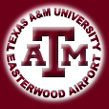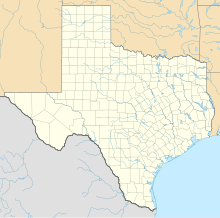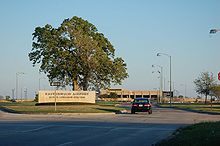Easterwood Airport
Easterwood Airport  | |||||||||||||||
|---|---|---|---|---|---|---|---|---|---|---|---|---|---|---|---|
 | |||||||||||||||
| Summary | |||||||||||||||
| Airport type | Public | ||||||||||||||
| Operator | Texas A&M University | ||||||||||||||
| Location | College Station, Texas | ||||||||||||||
| Elevation AMSL | 321 ft / 97.8 m | ||||||||||||||
| Coordinates | 30°35′19″N 96°21′50″W / 30.58861°N 96.36389°W | ||||||||||||||
| Map | |||||||||||||||
 CLL | |||||||||||||||
| Runways | |||||||||||||||
| |||||||||||||||
| Statistics (2019) | |||||||||||||||
| |||||||||||||||
Easterwood Airport (IATA: CLL, ICAO: KCLL, FAA LID: CLL, Easterwood Field) is the regional airport for Texas A&M University, Bryan-College Station and Brazos County, Texas. Reached from Farm-To-Market Road 60 West (Raymond Stotzer Parkway), it is three miles southwest of College Station[2] and 0.25 miles (0.40 km) from Texas A&M University. There is no public transportation from Easterwood Airport to the surrounding cities; however, in the fall of 2019, a new university bus route was established to connect Easterwood Airport with the Engineering Quad and the Texas A&M Hotel and Conference Center.[3] The airport bus route is available only to those with a University ID or Brazos Transit District ID. Despite owning and managing the airport, there are no aviation courses at the university.
The William A. McKenzie Terminal at Easterwood Airport provides daily flights to Dallas/Fort Worth, Houston and seasonal service to Birmingham (AL). The terminal has free 2 hour visitor parking and drop off areas on the upper level and shuttle/taxi pick up areas on the lower level.
The ticket counters, TSA security checkpoint, and boarding areas are on the upper level of the terminal. Baggage claim and rental car agencies are on the lower level.
History[]
In 1938 the Board of Directors of the Agricultural and Mechanical College of Texas (as Texas A&M was known at the time) authorized the development of an airport at the existing site. The University applied to the Civil Aeronautics Authority (CAA) for certification as a primary flight training school under provisions of the Civilian Pilot Training Program.
In May 1940 the airport opened, named for U.S. Navy Lieutenant Jesse L. Easterwood. Easterwood was a former A&M student who enlisted in the British Royal Naval Air Service in 1917. After being commissioned as Ensign, he was later promoted to Lieutenant in the Naval Air Service and was the second American to qualify as Naval Aviation Pilot. He served with the Royal Flying Corps in 1918 and had sixteen successful raids behind German lines. He served in three foreign countries and was killed in an airplane accident in the Canal Zone May 19, 1919. He was awarded the Navy Cross posthumously "for distinguished and heroic service as an aviator."
The facility in 1940 had one hangar and a turf landing strip and taxiway which were eventually paved through funding provided by the CAA, the Works Projects Administration (WPA), and Texas A&M.[4]
In 1948 a large hangar was relocated to the airfield from a US Army flying field near Corsicana, Texas. The FAA established a Flight Service Station (FSS) at the Airport in 1951 and Pioneer Airlines began scheduled air service in that year. Many changes have occurred including moving the Flight Service Station to Montgomery County and United Express and American Eagle now provide scheduled air service.
The first control tower was erected at the Airport in 1952 and a commercial passenger terminal was constructed in 1957. Work began on an extension of Runway 16-34 (now 17–35) to its present 7,000-foot (2,100 m) length in 1984. At the same time the parallel taxiway to Runway 16-34 was extended.
In 1988 work began on improvements to the Airport access road and construction of a new passenger terminal began. The new McKenzie Terminal opened in 1990 and plans were made to convert the old passenger terminal into a general aviation terminal. It was remodeled and re-opened for service in 1994 as a modern general aviation facility, housing line service and support personnel as well as flight operations.
Facilities[]

The airport covers 700 acres (280 hectares) and has two runways, 11/29, which is 5,158 by 146 feet (1,572 m × 45 m), asphalt and 17/35, which is 7,000 by 150 feet (2,134 m × 46 m), asphalt-concrete, all weather runway, an approach lighting system, an FAA control tower, FAA radio communication and an OmniRange-ILS Navigation Aid.[2]
In the year ending December 31, 2019, the airport had 56,749 aircraft operations, average 155 per day: 58% general aviation, 33% military, 9% air taxi and <1% airline. 50 aircraft were then based at this airport: 25 single-engine, 5 multi-engine, 18 jet and 2 helicopter.[2]
Transportation[]
No public transportation infrastructure is available at Easterwood. Thus, travellers must utilize private transportation options including taxis, rental car services, and ride sharing. Texas A&M University has a shuttle bus designated as "Route 7" that runs between the University campus and Easterwood Airport, and is only available to students, faculty, and Texas A&M hotel guests. There are a few taxi companies registered with the City of College Station and the Easterwood Airport management. Rental car offices are located inside the terminal, while designated spaces for taxis and ride-shares are found outside.
Airlines and destinations[]
This section does not cite any sources. (January 2022) |
| Airlines | Destinations |
|---|---|
| American Eagle | Dallas/Fort Worth |
American Eagle flights to Dallas–Fort Worth are operated by Envoy Air using Bombardier CRJ700s and Embraer ERJ145s.
| Destinations map |
|---|
class=notpageimage| Destinations from Easterwood Airport |
Statistics[]
| Rank | Airport | Passengers | Carriers |
|---|---|---|---|
| 1 | Dallas/Fort Worth, Texas | 28,590 | American Eagle |
| 2 | Houston, Texas | 11,150 | United Express |
See also[]
References[]
- Thole, Lou (1999), Forgotten Fields of America : World War II Bases and Training, Then and Now - Vol. 2. Publisher: Pictorial Histories Pub, ISBN 1-57510-051-7
- ^ Easterwood Airport, official web site
- ^ a b c d FAA Airport Form 5010 for CLL PDF, effective 2016-02-04
- ^ "Bus Route 7 | Texas A&M Transportation Services". transport.tamu.edu. Retrieved November 8, 2019.
- ^ 1946 aerial view
- ^ "RITA | BTS | Transtats". Transtats.bts.gov. Retrieved September 7, 2021.
External links[]
- Easterwood Airport, official website
- FAA Airport Diagram (PDF), effective January 27, 2022
- FAA Terminal Procedures for CLL, effective January 27, 2022
- Resources for this airport:
- AirNav airport information for KCLL
- ASN accident history for CLL
- FlightAware airport information and live flight tracker
- NOAA/NWS weather observations: current, past three days
- SkyVector aeronautical chart for KCLL
- FAA current CLL delay information
- Airports in Texas
- Transportation in Brazos County, Texas
- Buildings and structures in Brazos County, Texas
- College Station, Texas
- Texas A&M University
- University and college airports
- Airfields of the United States Army Air Forces in Texas
- 1940 establishments in Texas
- Airports established in 1940
- Universities and colleges in the United States

